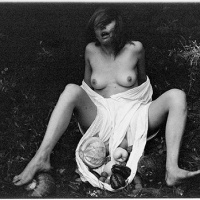Group Show part 2
Daido MORIYAMA, Issei SUDA, Tatsuo MIYAJIMA, Hajime SAWATARI, Keiichi TAHARA, Eiichiro SAKATA, Kou INOSE, Tatzu Nishi, William KLEIN, Antony Cairns
GALLERY HOURS | Tue.–Sat. 11:00–19:00 (Sat. 13:00–14:00 CLOSED)
CLOSED | Sun-Mon., National Holidays
WINTER HOLIDAYS | December 28 – January 6, 2025
Gallery selection: Daido MORIYAMA, Issei SUDA, Tatsuo MIYAJIMA, Hajime SAWATARI, Keiichi TAHARA, Eiichiro SAKATA, Kou INOSE, Tatzu Nishi, William KLEIN, Antony Cairns
Artists
Daido MORIYAMA
森山大道
Born 1938 in Osaka. After working as an assistant for photographers Takeji Iwamiya and Eikoh Hosoe, he went independent in 1964. He has been publishing his works in photography magazines among others, and received a New Artist Award from the Japan Photo Critics Association for Japan: A Photo Theater in 1967. Between 1968 and ’70 he was involved in the photo fanzine Provoke, and his style of grainy, high-contrast images that came to be referred to as “are, bure, boke” (grainy, blurry, out-of-focus) made an impact on the realm of photography. Solo shows at New York’s Metropolitan Museum of Art and the Fondation Cartier pour l'Art Contemporain in Paris solidified Moriyama’s worldwide reputation, and in 2012, he became the first Japanese to be awarded in the category of Lifetime Achievement at the 28th Annual Infinity Awards hosted by the International Center of Photography (ICP) in New York. The “William Klein + Daido Moriyama” exhibition together with William Klein at London’s Tate Modern in 2012-13 was a showdown of two immensely popular photographers that took the world by storm.
Issei SUDA
須田一政
Born 1940 in Tokyo. Graduated from the Tokyo College of Photography in 1962. Was hired as house photographer for Shuji Terayama’s experimental theater troupe Tenjo Sajiki in ’67, before commencing his work as a freelance photographer in ‘71. A Newcomer's Award from the Photographic Society of Japan for Fushi Kaden catapulted him into the limelight in 1976. He further received the Photographic Society of Japan’s Annual Award for the exhibition of the “Monogusa Syui” series in 1983, followed in ’85 by the 1st Domestic Photography Award at Higashikawa for “Nichijo no danpen”. In 1997, his book Human Memory received several awards including the Domon Ken Prize. In 2013, his large-scale retrospective exhibition “Nagi no hira – fragments of calm” was shown at the Tokyo Metropolitan Museum of Photography. His works capturing moments between reality and non-reality have lately earned a high reputation also outside Japan. Main photo collections include Fushi Kaden (’78), Waga Tokyo 100 (’79), Akai hana – scarlet bloom (2000), Fushi Kaden (definitive edition, 2012), Anonymous Men and Women (’13) and Rei (’15)
Tatsuo MIYAJIMA
宮島達男
Born in Tokyo in 1957. Completed postgraduate studies at Tokyo University of the Arts in 1986. Since his debut in Aperto ’88 at the Venice Biennale, he has been recognized as one of Japan’s foremost contemporary artists and has exhibited widely in Japan and internationally.
He represented Japan at the Venice Biennale in 1999 and has held major solo exhibitions at leading institutions including Hiroshima City Museum of Contemporary Art (1990), Hayward Gallery, London (1997), Tokyo Opera City Art Gallery (2000), Art Sonje Center, Seoul (2002), Museo d’Arte Contemporanea di Roma (2004), Art Tower Mito (2008), and the Museum of Contemporary Art Australia (2016). His works are held in the collections of Tate, London; Pinakothek der Moderne, Munich; the Museum of Contemporary Art Tokyo; among others. He has also realized large-scale public art commissions such as for TV Asahi at Roppongi Hills, Benesse Art Site Naoshima, Tokyo Opera City, and Leeum, Samsung Museum of Art, Seoul.
Miyajima is best known for his LED counter works, based on three key concepts: Keep Changing, Connect with Everything, Continue Forever. The counters, each blinking at different speeds and never displaying zero, evoke the continuity, eternity, and interconnectedness of time and human life.
He is the founder of the Revive Time: Kaki Tree Project, which propagates seedlings from a persimmon tree that survived the atomic bombing of Nagasaki and plants them worldwide. More recently, he has been engaged in the Sea of Time – TOHOKU project, which seeks to carry forward the memories of the 2011 Great East Japan Earthquake while envisioning a new future for the Tohoku region.
Miyajima’s solo exhibition is currently on view at the Asia University Museum of Modern Art, Taichung, Taiwan, through May 2026.
Hajime SAWATARI
沢渡朔
Born 1940 in Tokyo. Began to publish his works in photography magazines and elsewhere while still enrolled at the Department of Photography, College of Art, Nihon University. After working for Nippon Design Center, he became a freelance photographer in 1966. While working mainly as a fashion photographer, he has been publishing his works in numerous magazines such as Camera Mainichi. He produced a large number of masterful works including Alice, inspired by Alice in Wonderland, and Nadia, containing photos of an Italian fashion model (both 1973), and has since been continuously operating in the front lines of his field. Photo books include Nadia: Forest Sprite, Alice (both 1973), Taste of Honey ('90), 60's and 60's 2 (2001), and kinky ('09) and Nadia('16).
Keiichi TAHARA
田原桂一
Born in Kyoto in 1951, Keiichi Tahara moved to France in 1971.
He began his career as a photographer, captivated by the piercing light of Europe that was compared to the soft light of Japan.
In 1977, at the age of 26, he won the Grand Prize at the Arles International Festival for his series Fenêtre, 1973-1981 (Window) which acclaimed the international limelight.
Based in Paris until 2006, Tahara worked on projects for the French government in a broad range of genres such as photography, sculpture, installation, and architecture under the theme of ‘light.' He has held numerous exhibitions throughout Japan and Europe.
He received numerous awards including the Kimura Ihei Photography Award, the Prix Nicéphore Nièpce, Chevalier des Arts et des Lettres of France, and the Grand Prix de la Ville de Paris.
His major publications include Architecture de Fin de Siècle (Kodansha), Architecture de Fin de Siècle (Taschen America LIC), L’Opéra de Paris (Bunkensha), and Light-Sculpture-Photography (ASSOULINE/MEP), etc. While producing his own work, he also participated in various projects as the first Japanese branding consultant for international Maisons such as Cartier and Dom Perignon. In 2017, he operated the world's first large-scale exhibition at the National Gallery Prague.
He is currently holding a solo exhibition at VLC Gallery by AKIO NAGASAWA, which opened in Toranomon in October 2022. This space will introduce the works of Keiichi Tahara over a period of one year, divided into four exhibition periods.
photo ©︎Tadayuki Minamoto
Eiichiro SAKATA
坂田栄一郎
Born 1941 in Tokyo. After graduating from the Department of Photography, College of Art, Nihon University, he joined Light Publicity Co., Ltd for one year, before going to the USA to study under Richard Avedon. He subsequently published Chumon no ooi shashinkan (The photo studio of many orders), Talking Faces, and a string of other ambitious works that up to that point were unthinkable in Japanese portrait photography. Sakata has been shooting portraits for the covers of Aera magazine since its launch in 1988, and as a result of his relentless work, the number of people he portrayed so far amount to more than 1,000. In 2004, the exhibition ”Piercing The Sky” at the Tokyo Metropolitan Museum of Photography attracted much attention. Sakata received a Domon Ken Award and a Photographer Award from The Photographic Society of Japan in 2005. In 2013, the “Enoshima” series focusing on “portraits without people” was shown at the Hara Museum of Contemporary Art, and caused quite a stir as a groundbreaking new venture.
Kou INOSE
猪瀬 光
Born 1960 in Saitama. Started his career after studying photography under Seiryu Inoue while still enrolled at Osaka University of Arts. While having numerous devoted fans, he doesn’t present new works very often, as his extremely persistent approach is reflected in every single print that he finishes in up to one month of highly concentrated work. Charged with astonishing density and intensity, his works have been awarded a New Photographer Prize at the Higashikawa International Photo Festival in 1993. Photo books include deja-vu #11: Inose Kou (’93) and Inose Kou Visions of Japan (‘98). Solo exhibitions include the “Inose Kou Photo Exhibition” at Space Kobo & Tomo in 2001. He also participated in the group exhibition “Lonely Planet” at Art Tower Mito in 2004, and is presently one of those artists whose exhibitions are most anticipated.
Tatzu Nishi
西野 達
Born in Nagoya, Japan, 1960
Lives in Berlin, Tokyo and Atami/Japan
formerly known as Nishi Tatzu
William KLEIN
ウィリアム・クライン
Born 1928 in New York. His career as a fashion photographer began in 1955, followed in 1956 by the publication of New York. Breaking taboos in photography, he introduced a new style of audaciously blurry and out-of-focus pictures that went on to influence numerous photographers up to the present day. After New York, the series continued with Roma (‘59), Moscow (’64), and Tokyo (’64). In addition to working as a photographer, he also produced the fashion-related movie Qui etes-vous Polly Maggoo? A solo exhibition at the San Francisco Museum of Modern Art in 1995 established his reputation, which he had mainly earned in Europe, also back home in America. In Japan, the Tokyo Metropolitan Museum of Photography showed the “Paris+Klein” exhibition in 2004, and in 2005, the “William Klein Retrospective” exhibition was held at the Centre Pompidou in Paris. The exhibition “William Klein + Daido Moriyama” with Daido Moriyama at London’s Tate Modern in 2012-13 created a buzz not only in the realm of photography, but in the fashion and film worlds alike.
Antony Cairns
アントニー・ケアンズ
Antony Cairns (b. London, 1980) takes photographs at night, using the available light cast by buildings in urban centers like London, Tokyo and Los Angeles. In many cases the structures that he chooses are still under construction, little more than the skeletons of the office buildings and luxury apartments of that they are destined to become. His work is resolutely non-topographic, in the conventional sense in which photography has been used to record spaces, structures and architectural styles. There is more, however, to Cairns’s work than simply his distinctive approach to picturing the urban environment. His is a practice that accepts and embraces the photographic medium in its sophisticated entirety: from the effect use of light on analogue film, through a range of experimental darkroom processes, to an innovative and highly specialized understanding of the supports available to the photographic image in the twenty-first century.
Cairns presents his work in a number of complementary but contrasting ways: from painstakingly layered and assembled artists books LDN (2010), LPT (2012), OSC (2016); to translucent films of silver gelatin applied directly to sheets of aluminium, LDN2 (2013), LDN3 (2014); to experiments with electronic ink, both in working Amazon Kindle reading tablets hacked to contain his complete work, LDN EI (2015); and on their extracted frozen screens; strange distant descendants of the daguerreotype, TYO2 (2017). Cairns was also the winner of the 2015 Hariban Prize, resulting in a residency at the Benrido Collotype atelier in Kyoto. Once again faced with the possibility of extending and expanding the photographic image through its reproducible character Cairns made a series of interventions within, and interpretations of, the collotype process LA-LV (2016). Cairns has recently begun to explore the prehistory of the digital age in several related ways, by printing his works and assembling them as montages on early computer punch cards, OSC Osaka Station City (2016) and by using the screens of outmoded digital cameras and equipment to screen and project his work. He has a forthcoming project at the V&A in London in 2023. Cairns has exhibited and published widely, in Europe, the United States and Japan. He has published many books of his work including CTY (2017) with Morel Books/Akio Nagasawa Publishing and Computer punch card selected artworks (2021) with Morel Books.
He lives and works in London.





























